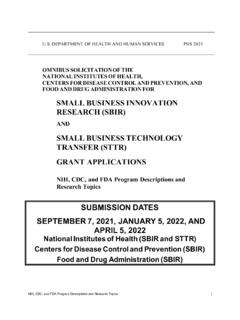Transcription of Chapter 16 - Anaerobic Wastewater Treatment
1 16. Anaerobic Wastewater Treatment Jules B. van Lier, Nidal Mahmoud and Grietje Zeeman SUSTAINABILITY IN Wastewater . Treatment . consumed. Accepting that Anaerobic digestion in fact Definition and environmental benefits of merely removes organic pollutants, there are virtually Anaerobic processes few if any serious drawbacks left, even not with respect The fermentation process in which organic material is to the rate of start-up of the system. Figure shows degraded and biogas (composed of mainly methane and the fate of carbon and energy in both aerobic and carbon dioxide) is produced, is referred to as Anaerobic Anaerobic Wastewater Treatment (AnWT) assuming that digestion. Anaerobic digestion processes occur in many the oxidation of 1 kgCOD requires 1 kWh of aeration places where organic material is available and redox energy.
2 In contrast to Anaerobic Treatment , aerobic potential is low (zero oxygen). This is typically the case Treatment is generally characterised by high operational in stomachs of ruminants, in marshes, sediments of costs (energy), while a very large fraction of the waste lakes and ditches, municipal land fills, or even is converted to another type of waste (sludge). Aerobic municipal sewers. Treatment in a conventional activated sludge process yields about 50% (or more) new sludge from the COD. Anaerobic Treatment itself is very effective in converted, which requires further Treatment , removing biodegradable organic compounds, leaving Anaerobic digestion, before it is reused, disposed off or mineralised compounds like NH4+, PO43-, S2- in the incinerated. The carbon/energy flow principles of solution. Anaerobic Treatment can be conducted in aerobic and Anaerobic bio-conversion largely affect the technically plain systems, and the process can be set up of the corresponding Wastewater Treatment applied at any scale and at almost any place.
3 Moreover system. Not surprisingly, to date, AnWT has evolved the amount of excess sludge produced is very small and into a competitive Wastewater Treatment technology . well stabilised, even having a market value when the so- Many different types of organically polluted called granular Anaerobic sludge is produced in the wastewaters, even those that were previously believed bioreactor. Moreover, useful energy in the form of not to be suitable for AnWT, are now treated by biogas is produced instead of high-grade energy Anaerobic high-rate conversion processes. 2008 Jules B. van Lier. Biological Wastewater Treatment : Principles Modelling and Design. Edited by M. Henze, van Loosdrecht, Ekama and D. Brdjanovic. ISBN: 9781843391883. Published by IWA Publishing, London, UK. 402 Biological Wastewater Treatment : Principles, Modelling and Design Heat loss 10.
4 Degremont, Envirochemie, GWE, Grontmij as well as 0k gC other local companies. To this number an estimated OD. number of 500 homemade' reactors can be added Influent + which are constructed by very small local companies or Aerobic Aeration by the industries themselves but which do not appear in (100 kWh) Effluent 12-10 kg COD the statistics. Analysing the reasons why the selection for AnWT. Sludge, 30-60 kg was made, the following striking advantages of AnWT. over conventional aerobic Treatment systems can be Biogas 40-45 m3. (~ 70% CH4). given: Influent reduction of excess sludge production up to 90%. 100 kg COD Anaerobic up to 90% reduction in space requirement when using expanded sludge bed systems. Effluent 10-20 kg COD high applicable COD loading rates reaching 20-35 kg COD per m3 of reactor per day, requiring smaller reactor volumes.
5 Sludge, 5 kg no use of fossil fuels for Treatment , saving about 1. Figure Fate of carbon and energy in aerobic (above) and Anaerobic (below) Wastewater Treatment kWh/kgCOD removed, depending on aeration efficiency. In countries like the Netherlands, almost all agro- production of about MJ CH4energy/kgCOD. industrial wastewaters are presently treated with removed, giving kWh electricity (assuming 40%. Anaerobic reactor systems. The application potential, electric conversion efficiency). in the petro-chemical industries, is rapidly growing. rapid start up (< 1 week), using granular Anaerobic Figure shows the gradual increase in the number of sludge as seed material. Anaerobic high-rate reactors from the mid seventies no or very little use of chemicals. onwards. plain technology with high Treatment efficiencies. Anaerobic sludge can be stored unfed, reactors can be At present, a total number of 2,266 registered full operated during agricultural campaigns only ( 4.)
6 Scale installations are in operation, which are months per year in the sugar industry). constructed by renowned companies like Paques, excess sludge has a market value. Biothane, Biotim, Enviroasia, ADI, Waterleau, Kurita, high rate systems facilitate water recycling in factories (towards closed loops). 2,400. 2,200. 2,000. 1,800. Number of plants 1,600. 1,400. 1,200. 1,000. 800. 600. 400. 200. 0. 1972. 1975. 1976. 1977. 1978. 1979. 1980. 1981. 1982. 1983. 1984. 1985. 1986. 1987. 1988. 1989. 1990. 1991. 1992. 1993. 1994. 1995. 1996. 1997. 1998. 1999. 2000. 2001. 2002. 2003. 2004. 2005. 2006. Year Figure Increase in number of world wide installed Anaerobic high-rate reactors in the period 1972-2006. Anaerobic Wastewater Treatment 403. Obviously, the exact ranking of the above driven plant it is half that value. At a foreseen stabilised advantages depends on the local economic and societal price of 20/ton CO2, the above exampled industry conditions.
7 In the Netherlands, excess sludge handling could earn 500/d on carbon credits (based on a coal is the cost-determining factor in operating Wastewater powered plant), whereas no fossil fuels are used for Treatment systems. Since land filling is no option for treating the Wastewater . Although this amount is excess sewage sludge and biowastes, while prices for negligible in industrialised countries, it could provide a incineration reach 500/ton wet sludge or more, the low real incentive in developing countries to start treating sludge production in Anaerobic reactors is an immediate the Wastewater using high-rate AnWT, and thereby economic benefit. The system compactness, another protecting the local environment. The carbon credit important asset of AnWT, can be illustrated by a full- policy can, therefore, be regarded as a Western subsidy scale example, where an Anaerobic reactor with a 6 m for implementing AnWT systems in less prosperous diameter and a height of 25 m, suffices to treat up to 25 countries.
8 Tons of COD daily. The produced sludge, which is less than 1 Ton dry matter per day in this example, is not a Table gives a summary of the expected energy waste product, but is marketed as seed sludge for new output as well as the predicted CO2 emission reduction reactors. Such compactness makes the system suitable (if the produced CH4 is converted to electricity) of an for implementation on the industry premises or Anaerobic reactor, operated at commercially available sometimes even inside the factory buildings. The latter organic loading rates. is of particular interest in densely populated areas and for those industries aiming to use Anaerobic Treatment as MICROBIOLOGY OF Anaerobic . the first step in a Treatment for reclaiming process water. CONVERSIONS. The renewed interest in the energy aspects of AnWT. directly results from the ever rising energy prices and Anaerobic degradation of organic the overall concern on global warming.
9 The above 25 polymers Tons COD/d of agro-industrial waste(water) can be The Anaerobic degradation pathway of organic matter is converted in 7,000 m3CH4/d (assuming 80% CH4 a multi step process of series and parallel reactions. This recovery), with an energy equivalent of about 250 GJ/d. process of organic matter degradation proceeds in four Working with a modern combined heat power (CHP) successive stages, namely: (i) hydrolysis, (ii). gas engine, reaching 40% efficiency, a useful MW acidogenesis, (iii) acetogenesis, and (iv). electric power output can be achieved (Table ). The methanogenesis. These are discussed below. overall energy recovery could even be higher (reaching up to 60%) if all the excess heat can be used on the Methanogenic bacteria are located at the end of the industry premises or direct vicinity.
10 Assuming that full Anaerobic food chain and, partly thanks to their activity, aerobic Treatment would require about 1 kWh/kgCOD no large quantities of organic matter accumulate in removed, or 1 MW installed electric power in the above Anaerobic environments, where this matter is case, the total energy benefit of using AnWT over the inaccessible to aerobic organisms. The Anaerobic activated sludge process is MW. At an energy price digestion process involves a complex food web, in of /kWh this equals about 5,000 /d. Apart from which organic matter is sequentially degraded by a wide the energy itself, current drivers include the carbon variety of micro-organisms. The microbial consortia credits that can be obtained by generating renewable involved jointly convert complex organic matter and energy using AnWT (Table ).










